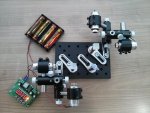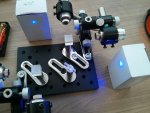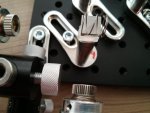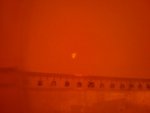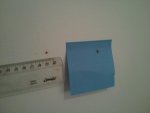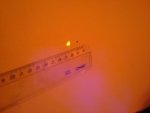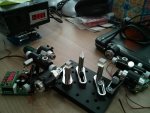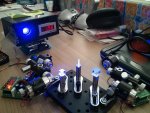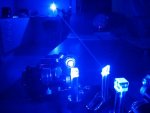- Joined
- Feb 12, 2016
- Messages
- 589
- Points
- 63
Since today is the long weekend in Spain when I do not have to go to work, but Labour Day what means that one has to work and not just stay idle, I decided to finally build the set up for combining 4 LDs. There was a lot of talking on LPF how this could be easily done but no one yet has posted a "working" set up.
So here is mine. Sorry for not making it very ergonomic but for doing experiments it seems fine: 4 laser modules, 2 Broadband PBS cubes, 1 445-462nm Dichro mirror.
This Blue-Blue Dichro mirror as I posted before can also work for combining 405+450nm, so here I have put 2 BDR-209 and 2 PLT5 450B diode modules.
And now the "unexpected results" of the 1st experiment:
Combining 2 PLT5 works fine - the beams are easily combined by finding the right polarisation positions as you see and most of the light is passing through the Dichro (picture made at 26mA current).
But combining 2 BDR-209 does not seem to work with same type of PBS - by rotating modules I cannot find a position where PBS would be transparent for any of the two beams, it looks that both beams in any rotational position are mostly reflected by the PBS! (I am talking here about PBS not Dichro)
What does it mean? Can the reason be that the 405nm lasers from BDR-209 may be not V/H but circularly polarised and I would need a 1/4 and/or 3/4 waveplates to combine them?
I thought that PBS-combining of single mode LDs does not need use of any WP but maybe I was wrong???
In 2014 Jander6442 has made a Maglite with two PBS-combined BDR-209 and it produced 1335mW if I remember it right. From two LDs each capable of 800-1000mw according to DTR tests!!! Could he encounter a similar problem without knowing it?
So here is mine. Sorry for not making it very ergonomic but for doing experiments it seems fine: 4 laser modules, 2 Broadband PBS cubes, 1 445-462nm Dichro mirror.
This Blue-Blue Dichro mirror as I posted before can also work for combining 405+450nm, so here I have put 2 BDR-209 and 2 PLT5 450B diode modules.
And now the "unexpected results" of the 1st experiment:
Combining 2 PLT5 works fine - the beams are easily combined by finding the right polarisation positions as you see and most of the light is passing through the Dichro (picture made at 26mA current).
But combining 2 BDR-209 does not seem to work with same type of PBS - by rotating modules I cannot find a position where PBS would be transparent for any of the two beams, it looks that both beams in any rotational position are mostly reflected by the PBS! (I am talking here about PBS not Dichro)
What does it mean? Can the reason be that the 405nm lasers from BDR-209 may be not V/H but circularly polarised and I would need a 1/4 and/or 3/4 waveplates to combine them?
I thought that PBS-combining of single mode LDs does not need use of any WP but maybe I was wrong???
In 2014 Jander6442 has made a Maglite with two PBS-combined BDR-209 and it produced 1335mW if I remember it right. From two LDs each capable of 800-1000mw according to DTR tests!!! Could he encounter a similar problem without knowing it?
Attachments
Last edited:


